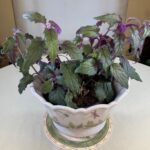Save Money by Propagating Your Own Houseplants |
Propagating, starting new plants from old ones, is easy and fun with houseplants. It’s the best way to create fresh plants from hard-to-find old favorites and is an inexpensive way to increase your indoor plant collection.
Most houseplants are easy to propagate, which is why they’re popular in the first place. Some plants even invite you to make new offspring by providing small, conspicuous plantlets. Springtime, when most houseplants are actively growing, is an excellent time to start new plants.
There are a variety of ways to propagate, but four methods in particular are used to reproduce most indoor plants.
CUTTINGS
The most popular means of creating new plants is to take cuttings and encourage them to form roots. Two types of cuttings exist — stem cuttings and leaf cuttings. To produce a stem cutting, remove a plant stem which has at least two or three leaf nodes (the point where the leaf attaches to the stem). Strip off the lower leaves and place the cutting in a rooting medium such as water, perlite, vermiculite or sphagnum moss. In a month or so it will root, creating a whole new plant.
Many plants can be rooted by stem cuttings, including anthurium, arrowhead vine, begonia, coleus, dieffenbachia, geranium, goldfish plant, hoya, iresine, lipstick plant, philodendron, polka-dot plant, pothos, prayer plant, purple velvet plant, succulents, Swedish ivy and wandering Jew. Leaf cuttings are done in a similar manner, using a leaf cutting instead of a stem. Two plants commonly rooted in this manner are African violet and sansevieria.
AIR LAYERING
Air layering is best suited for tall, lanky, single-stemmed plants, such as dracaena, ficus and split-leaf philodendron (Monstera deliciosa). It is a productive way to prune plants that have become too tall. The procedure is a simple one. You partially cut the stem and encourage root formation at that point by covering the cut with moistened sphagnum moss sealed with plastic wrap. Once roots form, remove the rooted portion and plant.
DIVIDING ROOTS
Some plants can be easily propagated by dividing their roots. This is usually done with plants that grow in clumps or form multiple growing centers. Each clump, also known as a crown, is divided into two or more sections and each section is replanted, making a whole new plant. African violet, asparagus fern, cast-iron plant, wax begonia, Chinese evergreen, most ferns, many palms, piggyback plant and spathiphyllum can be propagated in this manner.
USING THE PLANTLET
Other plants create a ready-made plantlet (runner) that appears as an appendage of a mother plant. Most of these tiny plants have aerial roots that grow at the end of long shoots. The easiest way to root runners is to place the base of the plantlet into a container filled with moist perlite or vermiculite and secure with a hairpin. Keep the cutting and planting medium moist by covering with plastic. Detach plantlet from the mother plant when roots have formed. Spider plant, strawberry begonia/geranium (Saxifraga stolonifera) and mother fern (Asplenium bulbiferum) are three plants propagated this way.
PROPAGATION TIPS
- Avoid damage to stems by first boring a hole in the rooting medium with a pencil.
- Always use clean tools. Sterilize tools with a one-part bleach to 9- parts water solution before doing any cutting.
- Don’t touch the surface of cuts as this will spread bacteria and may cause the cutting to decay before it has a chance to take root.
- Make smooth cuts; rough ones are subject to rotting.
- Increase your success rate by using a rooting hormone.
- Allow cuttings of succulents and cacti to dry and callous over for at least 24 hours before inserting in a rooting medium.



